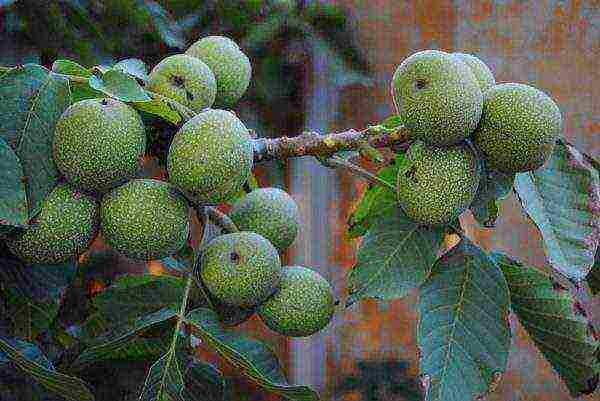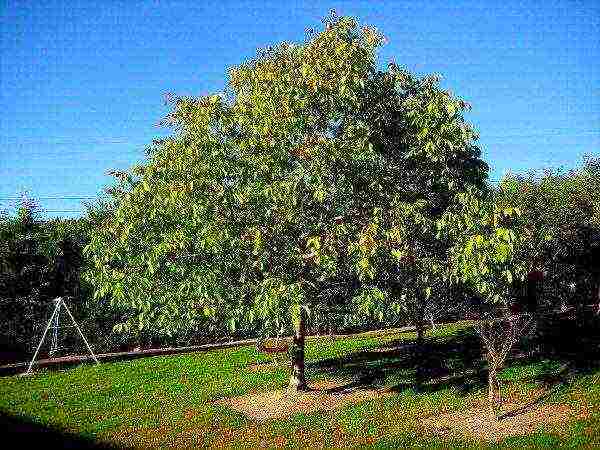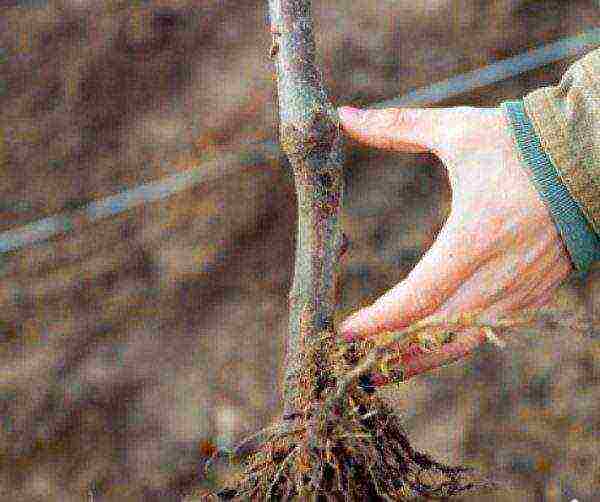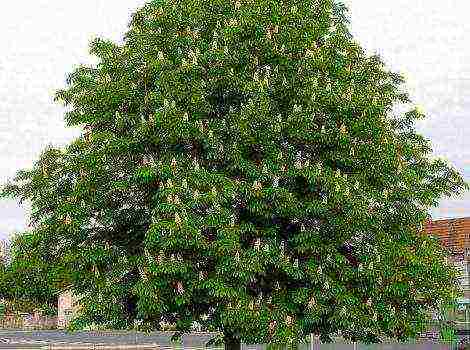Content
Detailed description of walnut Ideal
Walnut is a southern culture. This tall, deciduous tree is very demanding on heat, moisture and light.... Traditionally, it grows and bears fruit in places where the average annual temperature does not drop below + 10 ° C (Asia Minor and Central, the Caucasus, the Balkan Peninsula). Therefore, the cultivation of walnuts in most Russian regions is fraught with difficulties. The way out of the situation can be the cultivation of specially bred varieties. In the first place among them is the Ideal walnut.
Description of walnut varieties Ideal
A rather serious problem for the cultivation of traditional walnuts is their delayed entry into fruiting. Usually a seedling begins to produce only at the eighth, and sometimes at the fifteenth year of life.... Therefore, back in the middle of the 20th century, breeders received the task: to bring out a variety of early-growing walnuts.

The problem was solved in 1947 by walnut growers from Fergana (Uzbekistan). The honor of opening the Ideal variety belongs to the breeder S.S. Kalmykov.
Walnut Ideal is characterized by the following qualities:
| general description | A low-growing variety, does not grow above 4-5 m. The bark is gray, on 2-3-year-old shoots - brown, on annual shoots - gray-green, with slight pubescence. Leaves are pinnate. On vegetative shoots they are located spirally, on fruit-bearing ones - in the lower part of the shoot they are underdeveloped, in the form of scales. |
|---|---|
| Early maturity | Shows the first fruits already in the 2nd year of life. Good harvests can be obtained from the 5th year. |
| Flowers | Small white flowers with a greenish tinge, collected in a brush, 9-15 pcs. Wind-pollinated, dioecious. |
| Fruit | Large (on average 10 g), oval, with a thin shell. The kernel is light, easy to remove. Ripen from September to October. |
| Features of fruiting | Manages to form 2 crops per year. |
| Yield | High, up to 120 kg per tree. |
| Frost resistance | High, up to -35 ° C. |
| Disease resistance | Resistant to chlorosis. |
| Demanding soil | Able to grow on acidic or saline soils. Does not tolerate close occurrence of subsoil waters. |
Thus, among the advantages of the Ideal walnut, you can list:
- early maturity;
- yield;
- compactness of the tree;
- frost resistance;
- unpretentiousness;
- chlorosis resistance;
- the ability to form two crops per season.
Unfortunately, the Ideal variety does not differ in durability compared to traditional forms. If an ordinary walnut can live more 100 years, then early - only about 40-50.
Another drawback is that the flowers, falling under the spring return frosts, are often damaged. Fortunately, the ability to secondary bloom compensates for this disadvantage.
Breeding features
Ideal walnut is propagated by seeds or grafts. The process of growing it from seeds is fascinating and has a curious feature.: nuts should be placed in the hole close to each other, 4 pieces each. Then the seedlings will grow together and form a powerful and resistant plant.

Walnut fruits are sown either before winter or in spring after the snow melts. In the second case, it is necessary to stratify the nuts in wet sand during 1.5 months at a temperature + 7 ° C and plant already germinated material. The fruits are sealed in holes 10 cm deep.
In the first year, the development of seedlings is rather slow. By autumn, they grow to only 15-20 cm. But next spring, the nut shows a "growth spurt". When the height of the seedling exceeds a meter, you can wait for the first flowers.
Grafting walnuts is best done with cuttings.... The budding method is also used, but grafted buds are likely to freeze out in winter. Walnut grafting is not always successful, so you can often find self-rooted seedlings on sale than on a rootstock.
Sapling selection
Nevertheless, when choosing between a self-rooted and a grafted nut seedling, it is better to choose the latter. The fact is that in many seedlings obtained from seeds, the characters do not correspond to the parental forms. Walnut - cross-pollinated plantand the seeds may not retain the virtues of the variety.
When buying a seedling, you need to pay attention to its condition. Any damage to the bark, weak root system, rot on the roots should alert. Walnut already does not tolerate transplanting well., and additional "sore spots" can make this procedure destructive for the plant.
It is best to choose seedlings with a closed root system. Transplanting from a container along with an earthen ball will keep the root growth and suction zones intact.
Planting a walnut: step by step instructions
The site for planting a seedling should be well lit and sheltered from cold northerly winds. Walnut cannot stand tightness, and his crown is quite spreading, so you need to retreat at least 5 meters from other trees or buildings.

Despite the resistance of the Ideal variety to acidified soils, it will feel better on sod-carbonate loams. Swampy damp lowlands will absolutely not suit him.
Planting a walnut seedling includes several operations and is carried out according to this scheme:
- Soil preparation:
- On the day of planting the seedling, a planting hole is dug. It is not necessary to cook it in advance so that the soil does not dry out. Pit size - 60 * 60cm... If the soil is infertile, the size increases to 100 * 100 cm.
- The fertile layer removed when digging a hole, mixed with peat and mature compost in a ratio of 1: 1: 1.
- The soil mixture is enriched with fertilizers: dolomite flour - 500 g, superphosphate - 600 g.
- Preparing a seedling with an open root system:
- Clay talker is made: for 1 part of completely rotted manure, 3 parts of clay are taken, diluted with water to a creamy consistency and a root formation stimulator ("Heteroauxin" or "Kornevin") is added.
- The roots of the seedling are dipped in a chatterbox and left for half an hour to dry.
- Planting a seedling:
- Into the bottom of the pit support is installed... The soil mixture is poured into a mound.
- The seedling is placed on top of the planting mound.... The lower roots are distributed along the slopes and carefully covered with fertile soil. The upper ones are placed horizontally - so that the depth of their occurrence is in the region of 7-8 cm.
- The position of the root collar is checked... It should be 3-5 cm above the ground surface.

- The seedling is fixed to the support.
- The near-trunk circle is watered and mulched.
If a container seedling was purchased, then it just needs to be removed from the container along with the soil clod and transferred to the planting pit. After that, cover with prepared soil mixture and water.
Care after landing
2 weeks after planting, the walnut seedling should be well watered. Water consumption rate - 15-20 liters... If the region does not belong to the zones of sufficient moisture, in the future, careful monitoring of the state of the near-trunk circle will be required. Watering should be regular, but not excessive.
Walnut seedling Ideal needs crown formation. If the planting was carried out in the spring, you can make the first pruning immediately. If in the fall, you can postpone it until spring. In an ordinary garden, the walnut is formed into a "bowl"... To do this, choose 3-4 good skeletal branches and cut off the central conductor above the upper one.

In the future, pruning will need to be done annually. The main principle is to provide maximum illumination of all parts of the crown. To do this, remove all old and thickening branches. Walnuts bear fruit on annual growths, and it is they who need to be given the most sun.
For normal preparation for winter, the nut is stopped from mid-August. At the end of September, all the fruits are removed and the green tops of the shoots are cut off.... This procedure will force the plant to switch its forces from growth processes to the maturation of the wood.
Reviews of amateur gardeners
In our Primorsky Territory, the Ideal walnut survived winters with thirty-degree frosts and bore fruit normally every year. They collected 4-5 buckets from two trees. I don’t know the age of the trees, we bought a plot with them. Farm portal
An excellent variety - carpal, early-growing. It is a pity, it is difficult to find it in its "pure" form. There are many hybrids based on the Ideal. Also carpal, but the nuts are not like that. Forum-grapes
In February-March, there was a "burn" weather in the Moscow region. The bark was heated up to 15º during the day, and at night it was seized by frost. Walnut Ideal turned out to be sensitive, frozen out above the level of the snow cover. It is necessary to whitewash the bole high. Forum Anastasia
Conclusion
Grow a walnut in the Middle Lane or other by no means southern regions of Russia Is a real challenge. The Ideal variety successfully solves it. Of course, as the sun has spots, so the Ideal can be flawed. But many problems can be avoided by observing the rules of agricultural technology of this wonderful culture.


